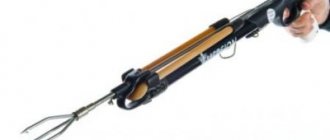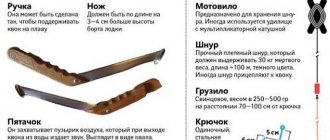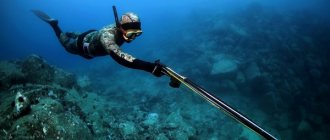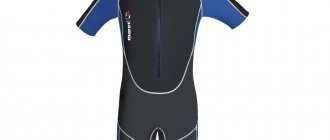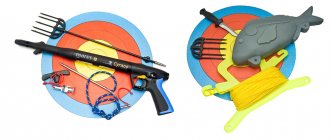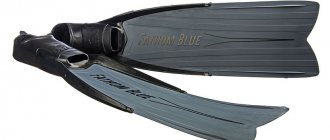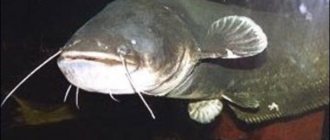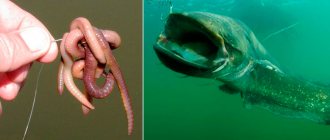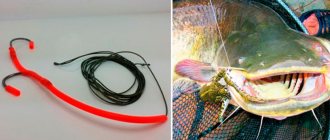Carp, pike, pike perch and even decent-sized crucian carp are desirable prey for underwater hunters, but nothing evokes such delight as catfish caught underwater. Underwater hunting for catfish can take place in a variety of bodies of water. Large water areas are inhabited by individuals whose weight exceeds 70-80 kg, and in small rivers and reservoirs you can shoot a smaller specimen, but its meat is very tender and tasty.
Some Internet resources contain not entirely truthful information about giant catfish. They say that meeting them is mortally dangerous; they can easily eat a hunter. Catfish really belong to the pronounced predators. After reaching a certain age and size, he can feast on an otter or a duck, but there have been no recorded cases of an attack on a person in order to fill his stomach. All fables posted online are fictitious sensations or the fruits of the irrepressible imagination of some fishermen. After accurately hitting a large catfish, the hunter really has a hard time, but not because the big fish is trying to swallow him. No, simply floundering prey can injure him; while holding it, he can get entangled in line or algae; some, due to inexperience, immediately enter into the fight and do not calculate their strength.
Tracking down and harpooning a predator is only half the battle; you also need to capture it. This is why experienced divers carefully prepare for each dive, check their weapons, gear and equipment, and think through their actions under water in advance.
Minimum Required
What does a hunter need to catch a catfish?
Weapon. Specialized stores offer a wide range of guns for underwater hunting, but you must understand that there is no universal underwater weapon. To catch a mustachioed predator you will need a powerful but short tool, convenient for working in cramped conditions. It should give the harpoon a high initial speed and have good stopping power. Going after the owner of a pond with a low-power, middle-class gun is the same as trying to catch him with your bare hands. Harpoons should be at least 8 mm in diameter, hardened to 40 units (HRC) on the Rockwell scale. If you hit a 20-kilogram catfish with a “raw” harpoon, it will simply bend, and the frightened fish will disappear into the darkness of the depths.
Cloth. The wetsuit can be equipped with a waterproof zipper or worn over the head, it does not matter. The main thing is that it matches the season. In the summer, when there is no particular need to insulate, products of medium modularity are used, and in the cold season (early spring, late autumn) it is better to give preference to a thick suit and be sure to wear thermal underwear underneath. It must be selected strictly according to size to avoid chafing and other unpleasant moments. An excellent choice would be a wetsuit, the color of which imitates aquatic vegetation; in this you can get almost close to the prey.
Basic equipment. Experienced tricksters hunt for catfish wearing masks made of opaque silicone with a small space under the mask. There are only two requirements for the tube: flexibility, as well as an optimal ratio of diameter and length. The tube fastenings sometimes fail, so it is better to tuck them under the mask belt. This will prevent the tube from coming off in case of a hard snag and will allow you to move it to the back of your head if necessary. It is advisable to wear closed fins, since models with an open heel cling to plant stems with their buckles and straps.
Flashlight. The catfish rests during the day and is active at night. The constant movements of the predator at night make it difficult to search for it, but if there is a powerful light source that can illuminate the underwater darkness, the dive can be effective. A special waterproof lighting device helps you see catfish in absolute darkness. They usually use compact, easy-to-use flashlights with a dimmable system that allows them to switch to the desired mode when a fish is detected. In addition to the ability to dim the light, when choosing a flashlight, you should take into account characteristics such as buoyancy and operating time on a single charge.
Best time to hunt
In May, when the water warms up to 17-18 degrees, the catfish goes to spawn. It is prohibited to hunt it during this period; you can start only after the official lifting of the ban. Summer brings comfort, but with its arrival the transparency of the river water decreases, making it quite difficult to look for the mustachioed giant in it. This is why many tricksters are looking forward to autumn, because for them it is the same golden time as for mushroom pickers. In autumn, the water becomes lighter and visibility improves significantly, creating all the conditions for successful dives.
Underwater hunting for catfish takes on a completely different character, it becomes not only prey, but also gambling, truly exciting, giving a lot of vivid sensations and unforgettable impressions. With the approach of cold weather, catfish move to greater depths and prepare for wintering. According to the fishing rules, fishing in wintering pits, as well as any other method of catching it, is prohibited. The half-asleep catfish is of no interest, either sporting or otherwise. In general, shooting at underwater inhabitants that cannot offer resistance does not bring any pleasure.
Search for catfish sites
You can meet a predator in the most unpredictable place, but most often it takes cover:
in the thick of aquatic vegetation;- on river edges;
- in coastal pockets and niches formed at river bends;
- in holes and passages dug by beavers;
- among the flooded tree trunks.
When exploring the bottom horizons, it is worth periodically looking up. Decent specimens often rest in the recesses of a steep wall, which can be carefully approached from below. Smaller individuals seek protection from penetrating sunlight under the broad leaves of egg pods and other plants. Inspection of beaver burrows requires special care. Beavers don't dig mazes. There is only one way out of such shelters, so you cannot get too close to them, otherwise you may suffer from a strong blow.
On overgrown lakes, torn out plants and other floating debris form roofs under which catfish like to rest. Closeness and darkness are all he needs during the day. Under artificial roofs, large individuals lie peacefully on the bottom, and small catfish hang in the water column. Of course, hunting in such conditions is not easy; you have to make your way through the thickets with your hands, but the result will justify the effort.
At great depths, where there is no grass or snags, catfish rest on the clean bottom. Sometimes several giants can be found in one place at once, although this fish is not considered a school. In this case, you should approach the object from behind or at least from the side, using maximum caution.
Finding the location of the trophy
If you have purchased a good gun and are now going to test it in real conditions, do not rush to dive immediately after arriving at the pond. Be sure to explore the coastline , paying special attention to snags sticking out in the slow current, overgrown with grass and other vegetation. If there is a weak current underneath them and there are schools of fry, then there is definitely a catfish nearby. And don't be surprised if you manage to meet him after your first dive.
If you dive deeper, you can find many fallen trunks, where predators are constantly found. However, getting to such a place can be difficult, so try to carefully think through the route and find a promising passage to the nest.
To make a shot, it is better to swim from the side, back or top of the blockage. By approaching the fish from the front, you are exposed to the current, which can push you against the branches.
It is difficult to catch decent prey at great depths without special skills and effort, because underwater holes are the best shelter for a predator , so it feels at home there, in its territory. It is better for a novice harpooner to attack fish in shallow water areas.
Don’t forget to explore other promising places where catfish may be found. This inhabitant of the deep often basks on or under a log without creating any movement. As for the largest individuals, they are almost always located at the bottom, resembling the same thick and gray logs.
After a thorough examination of the bottom, also look up, because sometimes there are quite decent specimens there.
If there are former beaver burrows in the reservoir, then the chances of catching catfish there rise to the maximum. In a huge beaver hole, real “monsters” are often found, the size of which exceeds any expectations. But remember that there is only one way out of such a depression, so a collision with a water giant can cause you a significant blow and even damage.
Coastal depressions and niches in vertical underwater steep walls are also an attractive place for fish. If you look into such a place, it is quite possible that you will see the belly of a large catfish there.
The nuances of spearfishing for catfish
Beginners prefer to shoot the fish in the head, but to penetrate it you will need a powerful gun. If the weapon does not have enough power, you can shoot at other parts of the body, with the exception of the stomach. It is soft, so holding the trophy after being hit will be very problematic. Many hunters aim at the tail, hoping that the arrow will go right through and securely lock into the body of the mustachioed predator. In addition, you can immobilize the fish with a precise shot in the spine. All this comes with experience, thanks to which the trickster is already oriented on the spot and makes the right decision when aiming at his victim.
How to keep a catfish after a successful shot? It is unreasonable and dangerous to hold back the first strong jerks; it is better to swim a few meters after him, trying not to pull the line into a string. You can let him “walk” for a while, alternately releasing and pulling the line. This way he will quickly become exhausted and stop persisting.
How to defeat a catfish?
Beginning underwater hunters most often shoot at the head of the fish. You can shoot anywhere, but you need to do it in such a way that the prey can be kept from leaving.
It is best to shoot in the middle of the spine without hitting the gallbladder. Then shoot in the tail or head and, holding the carcass by both arrows, pull it ashore.
A wounded catfish scurrying around poses a danger to a hunter. Therefore, after the first shot it is necessary to retreat from it. Then dive towards the prey and, using a kukan needle, pierce the labial part of the jaw , securing the kukan to a thick branch or trunk. After this, the fish is freed from the arrow and line and rises to the surface.
The catfish is a trophy worthy of admiration. But it’s better to go catfish spearfishing with a partner, who will be nearby in difficult times.
ulov.guru
Some safety tips
Useful recommendations for beginner underwater hunters:
You can only hunt if you are in good physical shape; weakness or malaise is a serious reason to refuse spearfishing.- Before diving, it is mandatory to check the weapon and equipment (condition of the line, operation of the reel, attachment of the knife, and so on).
- One dive requires one shot and no more, otherwise excitement will lead to the situation under water getting out of control.
- When fighting a strong opponent, you cannot force events: pull him up with force, wind a line around your hand, grab an arrow, and so on.
- It is advisable to hunt together with a partner who will help in difficult times.
Underwater hunting for catfish will be productive and interesting if you follow all safety rules in the water.
Equipment
Both dry and wet wetsuits are suitable for catfish hunting. If you have to look for fish at great depths or fight a strong current, you should use powerful fins, while short and soft ones are suitable for hunting in rubble or reeds. Fins with a buckle or open heel are not suitable for spearfishing. The presence of a tube will make it convenient to inspect grass thickets.
When hunting catfish, it is better to have a powerful compact air gun that will confidently pierce a 30-centimeter carcass from a two-meter distance. It would be a good idea to have an underwater light, a shock absorber and a line reel on your gun. The thickness and length of the line is selected by each hunter based on the situation on the reservoir and the expected size of the trophies. Typically, a line is used that is 25 meters long and at least 3 mm thick.
Since catfish do not have scales, it is better to take harpoons (arrows) with two petals for hunting. A harpoon with a diameter of about 8 mm , with a single-pronged tip with two petals, is suitable.
The arrow can be heated to 45 units or unheated. The latter is good because the catfish probably won’t break it.
